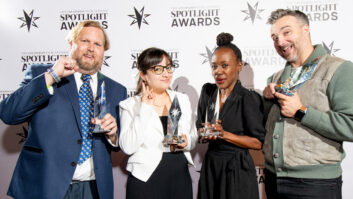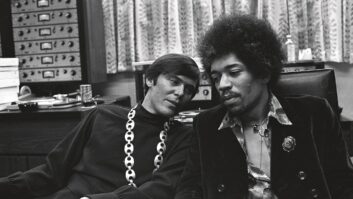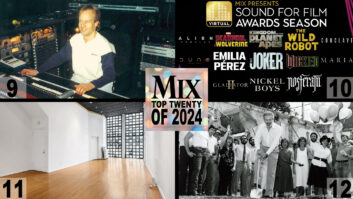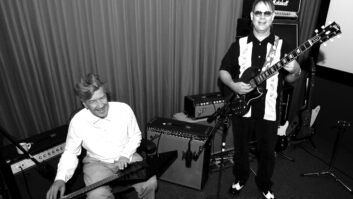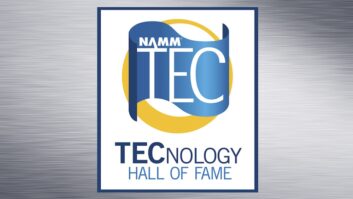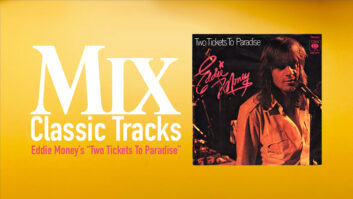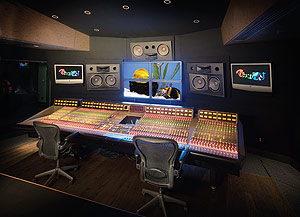
It’s always been about the vibe. From the moment maverick owners Gary Kellgren and Chris Stone opened Record Plant L.A. in 1968, ushering in an entirely new level of client service and rock ‘n’ roll comfort, the vibe was ready and waiting. Jimi Hendrix felt it; so did John Lennon and Paul McCartney. Frank Zappa, The Eagles, Bruce Springsteen and three mega-years of mid-’70s Stevie Wonder. Prince, Michael and Janet Jackson, Pearl Jam. Celine, Mariah and Barbara. Nine Inch Nails, No Doubt and the Black Crowes. And just in the past few years, Kanye, Christina, John Legend, Evanescence, will.i.am and everything that producer (now Geffen/A&M head) Ron Fair brings through the door.
The monitor wall was rebuilt to complement the SSL 9000 J installation; the four plasma screens have been dubbed “the fish tank.”
Photo: Ed Freeman
But it’s not just the history or the amazing run of 38 years that we pay tribute to on this month’s cover. We also salute the Record Plant’s intangible vibe, which has remained vital all these years, yet continues to stay fresh.
“The overriding philosophy has always been to make this place a creative workshop, a place where artists can bounce off each other and interact on a creative level,” says Rick Stevens, a former record company head and co-owner since 1991. “That’s something you can’t get at home, and I think that’s why when you look at the artists who have come through here, they’ve been the top acts of their era. The access, the social and creative interaction will always be a big reason people come here.”
“It’s no different now than it was back when I started,” says Rose Mann-Cherney, who virtually changed the profile of the modern studio manager before becoming studio president in 1998. “People made deals in the halls and popped their heads in to hear mixes, whether it was The Eagles or Guns N’ Roses. And today, you just know that Ron Fair will be arranging strings for John Legend in a couple of weeks. You will see Tal Herzberg bouncing ideas off Pharrell.”
Stevens and Mann-Cherney form a dynamic team, with the former handling business and long-term planning, the latter operations. But it hasn’t been an easy past five years in big-studio world, both freely admit, as CD sales have dropped, label budgets disappeared and personal studios proliferated. Having weathered the storm, however, with the past two years being “very good, thank God,” they have redone their flagship room (SSL-1, on the cover) and laid the groundwork for Record Plant South Beach (Miami).
“Rick and I are rolling the dice,” Mann-Cherney says. “I am sick of the doom and gloom, and you can print that. It’s been rough and it’s a fight to the finish, but I don’t think the record industry is dying. The record industry is reinventing itself, redefining itself, and we have to do it with them. I’m proud of the fact that we’re able to remodel our studios at this time. It’s a real achievement.”
The Record Plant was built on client service and ambience, on knowing who needs an air purifier, who doesn’t like to sing with the A/C on and who likes only green M&Ms. At the same time, the technical backbone, with an impeccable attention to maintenance and readiness, has always provided the foundation for seamless, flexible, creative music-making.
The room was originally designed by Peter Grueneisen, and in December of last year, Vincent Van Haaff was called in to “update” SSL-1 to accept an incoming 9000 J Series. The front monitor wall was completely rebuilt, with the center custom Augspurger removed and replaced by a four-plasma array (above; dubbed “the fish tank”). The J was pushed forward just a bit and some outboard was moved to a sidewall. The producer’s desk moved up, cabling was reconfigured and then they turned to the back wall.
“The room was well designed in the first place,” says Van Haaff, of Waterland Group. “But there was an area of shallow RPG Diffusors in the rear that seemed to be overly reflective in the midrange. We ended up removing the largest portion. The unusual U-shaped couch helps there. We also added dual EAW subs. We didn’t have to do much to the ceilings; most of my work was from the waist down. [Laughs]”
As Van Haaff finished up at the end of 2006, 28-year-old Jason Carson led the install of the wrap-around 9000 J in the five days between Christmas and New Year’s; a Pussycat Doll was booked for January 2. A graduate of Berklee College of Music, Carson served as a runner for two years before choosing tech over engineering. Mann-Cherney, a shrewd judge of talent, tapped him as chief engineer three years ago.
“We had a number of options,” Carson says. “We had straight control surface, analog or something in between. The clients demanded analog. We found the right board in England; a single owner. Then the company we dealt with in getting it over, Sonic Circus, was amazing. It was in great shape. We just had to extend the cables and change the patchbay layout. It’s been fantastic. A pretty amazing transition in this day and age that Rick and Rose are willing to make.”
And it just keeps moving forward for Record Plant, the “Lady of Rock” that always stays young. Next stop is South Beach, Miami, a second home for Stevens since his UM days. The property is in escrow at the time of this writing, and legendary Latin producer Rudy Perez will be a partner and creative director. Three world-class rooms, with an umbrella for seven to eight on-site artist-owned Studiominiums™. More will follow, you can be sure. Bring on the vibe.
Tom Kenny is the editorial director of Mix, Electronic Musician and Remix magazines.

